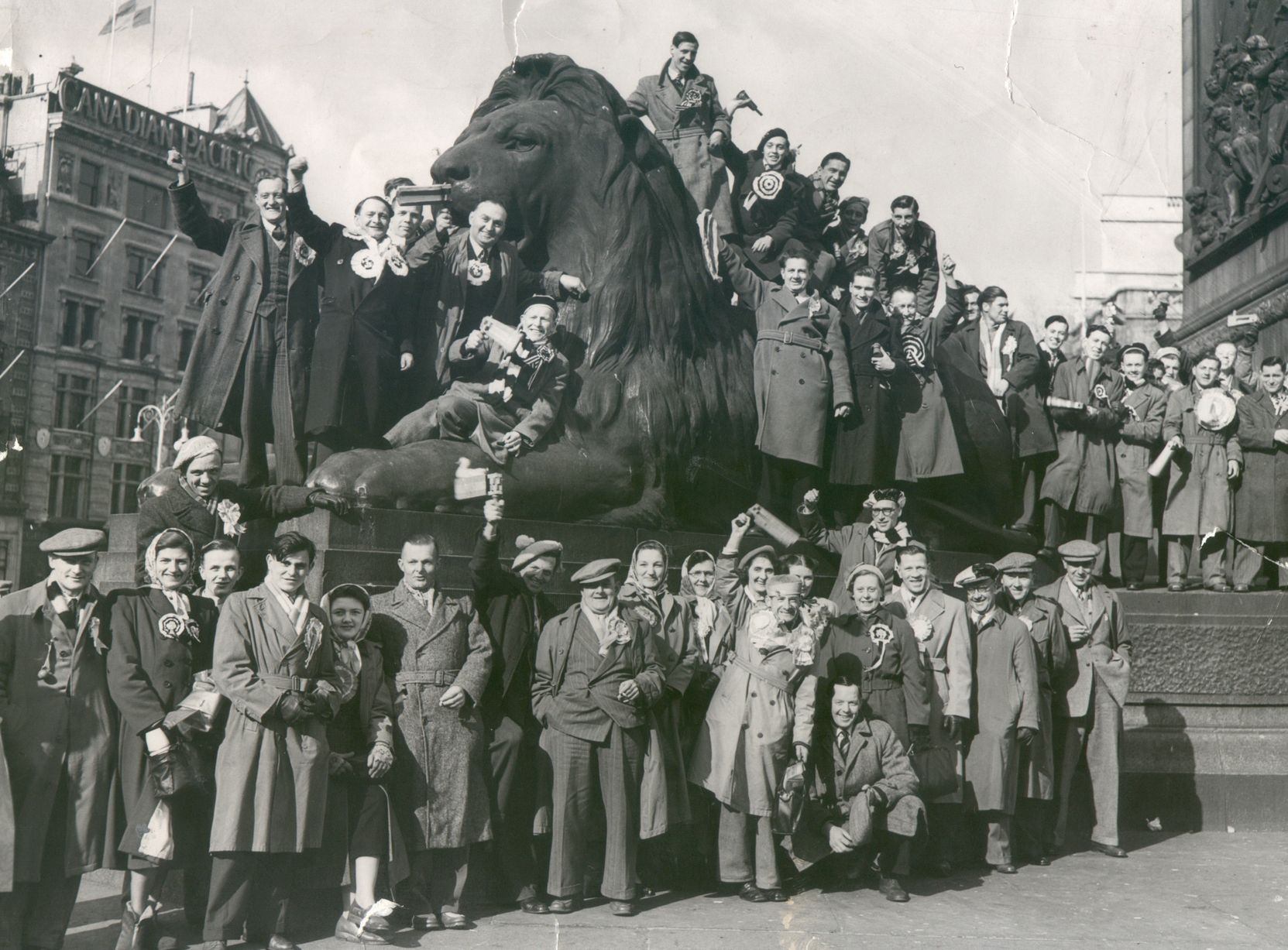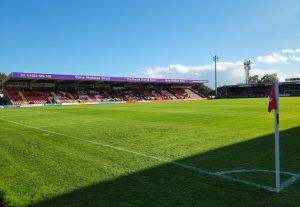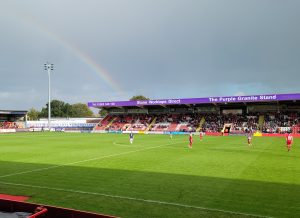Kidderminster Harriers 2 Ashton United 0
FA Cup 4th qualifying round
Saturday 14 October 2023

red read
The context
There are mellow days every season when the trees turn, leaves begin falling and smaller clubs dream about glamorous FA Cup ties. Kidderminster had recent form; they very nearly beat West Ham here in January 2022, eventually losing after extra time. I knew their ground well but today would be John’s first visit, as well as a rare foray for him into non-League. It felt like introducing two good friends and hoping they got on.
The history
I made many 1980s and 1990s trips here supporting Telford. The werewolf-infested Wyre Forest divided Shropshire and Worcestershire symbolically enough for our two cultures to feel dangerously diverse; both clubs were also enjoying unprecedented (if transient) success, so something of a rivalry ensued. Matters reached their apogee when two 1989 FA Trophy matches achieved impressive levels of off-field violence.
A strong smell of vinegar always hung over Kidderminster. For many years I believed this aroma – which invariably made me fancy fish and chips – had something to do with the town’s many carpet factories. It actually emanated from British Sugar at Foley Park, where locally grown beet was processed. Little else here seemed refined in our prejudiced eyes; we definitely endorsed Nicholas Pevsner’s assessment of the place as “uncommonly devoid of visual pleasure and architectural interest.”
Sugar beet was transported by rail via Foley Park sidings. These freight workings used the Severn Valley line’s final stretch of operational track, later incorporated into its existing heritage line from Bridgnorth via Bewdley. This has now been extended to a 1980s-era faux-Victorian Kidderminster Town station on Comberton Hill; preserved lines adjoin Harriers’ ground at Aggborough.
The original railway connected Hartlebury with Shrewsbury and missed out Kidderminster completely. Modern passengers travel on the former Bewdley loop line; this opened in 1878 to enable direct services through Kidderminster Junction to Stourbridge and Birmingham. Today’s terminus and platforms are more modern than they look, having been built from scratch – albeit showing considerable attention to detail – over former sidings beside Kidderminster’s British Rail station.
Aggborough dates from 1886. Local rugby and athletics enthusiasts first set up a football team there; Kidderminster Harriers became Birmingham & District League founder members three years later, along with rivals Kidderminster Olympic. These two subsequently merged as Kidderminster FC. The club – soon adopting their old Harriers name once more – played in this competition (today’s West Midlands Regional League) for seventy-one years, winning it six times.
The club built a new grandstand during 1935 and converted its banked running track for cycling. Little else changed for a hundred years, apart from one innovation that made Aggborough famous. Prototype floodlights had been tested at Revo Electric’s Tividale ground in 1951; Harriers quickly ordered some, and their 1955 match against Brierley Hill Alliance made history as the first ever floodlit FA Cup tie.
Two controversies define Harriers’ more recent history. The first came in 1983, when they finished Southern League runners-up but were selected for promotion ahead of runaway champions AP Leamington. The latter – whose ground had been deemed inadequate – rapidly declined and went out of business not long afterwards. Their highly-rated manager Graham Allner moved to Harriers along with his best players, kickstarting a period of expansion.
Kidderminster won the 1987 FA Trophy but Allner’s greatest achievements came during 1993-94. His part-time players were Vauxhall Conference champions and also reached the FA Cup fifth round, winning at Birmingham City and beating Preston here before losing narrowly against West Ham. But Harriers already knew that finishing top counted for little; in a curious echo of the AP Leamington affair, they had already been refused promotion to the Football League because of Aggborough’s tiny seated stand.
Harriers regrouped, called in the builders and eventually went up in 2000. It felt six years too late. Allner’s talented yet inexpensive side had been broken up, and crowds declined even as Jan Molby spent a small fortune to secure and then maintain League football. The collapsing ITV Digital bubble exposed naïve financial planning; relegation soon followed. Apart from one abortive play-off appearance they have seldom come close again.
The journey
Our drive from Cannock took us through quiet, sunny villages beyond Halesowen and Hagley. We parked on what was once Kidderminster’s cattle market. On my first visit, almost exactly forty years ago a mate’s uncle had done exactly the same; today, however, this simple exercise took more time than you might expect. First there were delays while while John tried to work the parking machine, and then I got distracted by some steam trains that happened to be passing.
The ground
Telford fans felt optimistic in October 1983. We were fresh from applying for League membership and had just won the Trophy, so regarded newly-promoted – and winless – Harriers as decidedly poor relations. Aggborough didn’t look like much, either. That 1930s grandstand still crookedly overlooked the weed-infested cycle track, while a basic terrace cover stood opposite. If Leamington’s Windmill Ground was worse then that must have been pretty rough.
Inevitably of course they beat us 1-0, appointed Allner the following week and never looked back. As we know, however, the ground failed to keep pace; a new stand would have been ready in time had not that record-breaking Cup run delayed demolition of their old one. What you see today is unrelentingly functional, as though Harriers were grimly determined to drive a permanent stake through those ground-graders’ vampire hearts.
Two solid terraced ends went up in 1993. The current main stand is equally prosaic, while a smaller version opposite finally hid all traces of the cycle track and permanently removed Aggborough’s distinctive oval shape. (This quirk had never really been troublesome for spectators because of the track’s steep banking. Although fans stood some way back they were still positioned well above pitch level.)
You can see more pictures here .
Flesh and wine
This is one of those places that spoil you for choice. Captain Cod’s legendary chip shop, sundry other takeaways, several decent pubs and the Severn Valley Railway real ale lounge can all be found on Comberton Hill. The ground offers two social clubs and a long-standing reputation for serving up great matchday food. Town or ground? Our debate would have graced the Algonquin Round Circle in its prime. Banks’s mild swung matters and we headed for Aggborough.
The Social & Supporters’ Club décor hadn’t changed much in four decades. John and I lurked quietly there until arriving Tamesiders swelled bar queues beyond our (admittedly limited) tolerance, and then wandered over to the newer version on Hoo Road. We never made it, though, as bottled Batham’s – fondly remembered from my days living in nearby Brierley Hill – was available from a garden shed-type contraption nearby. This seemed well worth braving the occasional shower for.
Catering manager Brian Murdoch’s family business fed supporters here for almost sixty years. His cottage pies won many prizes, while the tasty soup became so much part of Harriers’ folklore that a fanzine was named after it. New suppliers recently took over following Brian’s death in 2020. They still offer cottage pie but another man had just bought the last one.
The game
We sat in the main stand. It provided good views combined with superficial respectability, although any thoughts of quietly dozing for ninety minutes soon disappeared thanks to Ashton’s energetic media manager – whose press box seat was immediately behind us – and an equally excitable gentleman on our right. Their polar opposite views about the Northern Premier League underdogs would supply this afternoon’s defining tension.
The visitors might have been ahead early on when Christian Dibble saved smartly from Marcus Cusani. But two divisions separated these sides, and Harriers unsurprisingly began to dominate. Sammy Robson’s accurate crossing resulted in near misses by Amari Morgan-Smith and Kieran Phillips, while Luke Simpson dealt well with Barry Maguire’s long range effort. It felt like the eve of destruction for Ashton.
Kidderminster’s superior fitness became even more apparent as the match progressed. Ashley Hemmings began to find more space for tricky wing play, and chipped them ahead from outside the box. His header from Caleb Richards’ long ball shortly afterwards decided matters; Phillips, Zak Brown and Kobe Hall might well have added more. Louis Potts almost grabbed a late consolation but headed against the bar.
Teams and goals
Kidderminster: Dibble, Robinson, McNally, Penny, Richards, Oxlade-Chamberlain, Maguire, Hemmings (Hall 89), Phillips, McDonagh (Brown 57), Morgan-Smith. Unused subs: Palmer, Knight-Percival, Lissimore, Rubio.
Ashton: Simpson, Cowan, Newton, Couto, Burke, Cusani (Potts 67), Byrne, Rose, Gilchrist, Lowe (Milner 25, Baird 73), Hardy. Unused subs: Lonsdale, Bianga, Robbins, Caton.
Goals: Hemmings 66, 72.
Attendance: 2064.




















